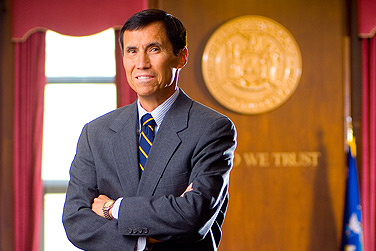News
Taxpayers paying for ineffective
sex-offender treatment programs

Charles Ewing says U.S. and New York State taxpayers are spending billions of dollars on sex-offender treatment programs that are largely “cosmetic.” Photo: DOUGLAS LEVERE
-
 Print
Print -
 Comments
(1)
Comments
(1)
-
“We, the American and New York State taxpayers, are being hosed, to put it bluntly.”
Federal and state governments have shelled out billions of dollars on programs to track, treat and punish sex offenders—even as those programs do little or nothing to prevent recidivism, SUNY Distinguished Service Professor Charles Patrick Ewing told a crowd of about 100 attending his UBThisSummer lecture yesterday in Talbert Hall.
“My conclusion is thumbs down,” said Ewing, the Law School’s vice dean for legal skills. “We, the American and New York State taxpayers, are being hosed, to put it bluntly. We’re spending billions of dollars that largely go for cosmetic programs.”
Ewing’s talk, appropriately titled, “Perverted Justice: Sex Offenders and the Law,” focused on four issues: civil commitment laws, which allow states to lock up sex offenders indefinitely; Megan’s laws, which require sex offenders to register their address and other information for use in public databases; sentences for possession of child pornography that are so severe that they are sometimes harsher than sentences for actual molestation; and attitudes driving increasingly harsh punishments for solicitation of sex from minors over the Internet.
Under civil commitment laws, a judge or jury can order “sexually violent predators”—offenders who, in essence, are found likely to commit criminal sexual acts again—to remain in state custody against their will, even after finishing a criminal sentence. These laws allow states to commit offenders indefinitely to hospitals where they can receive treatment if they admit to their crimes, though many already have completed multiple treatment programs. (In California, Ewing said, three quarters of convicts in such facilities refuse treatment.)
The result is a system that is expensive but doesn’t work, Ewing said: “There are no data to establish that this treatment is effective in reducing recidivism.” New York State spends at least $225,000 on each hospitalized individual, more than five times what it costs to keep an inmate in state prison. And civil commitments, which states often apply to convicts sentenced long before those laws went into effect, raise legal questions—with the U.S. Constitution forbidding ex post facto laws and the trying or convicting of a defendant more than once using the same set of facts.
The hospitals involved in civil commitments are “really prisons,” Ewing said. “We have two in New York State now, and they’re more secure than Attica.”
The patients, Ewing said, are really “inmates.” “These are people who are being locked up. They’ve served their time. They’re being locked up. Why? Because, well, we think they’re going to commit future crimes.
“We don’t usually lock people up because we think they’ll commit crimes in the future,” Ewing added.
Megan’s laws, another costly regime, enlarge public bureaucracies while doing little to keep the public safe, Ewing said. In some cases where states have gone further and restricted where sex offenders can live, work and travel, recidivism rates have actually risen, Ewing said. Stringent regulations have pushed some sex offenders into the margins of society, with one colony of convicts residing beneath a highway bridge in Miami.
Ewing ended his lecture with a discussion of sentences for possession of child pornography and Internet solicitations of minors, pointing out the irony in the fact that sentences for these two types of crimes often exceed sentences for crimes including actual molestation, statutory rape and even homicide.
The mean federal sentence for possession of child pornography rose 443 percent between 1997 and 2007 to 91.3 months. While child pornography is repulsive, Ewing said, the severity of such sentences doesn’t necessarily make sense. He noted that, “You can kill somebody and get five, 10, 15 years.” Data indicate that consumers of child pornography are, generally, not hands-on offenders, Ewing said.
“America has declared war on sex offenders,” Ewing said, and in doing so, “We’ve gone off the deep end.” He explained that he is not against spending money on interventions that work—ones like an FBI operation that targets distributors of child pornography and has rescued more than 100 children who were being sexually abused. What he opposes, he said, is wasting taxpayer dollars on programs that are ineffective.
The UBThisSummer Lecture Series will take a break for the Independence Day holiday and return on July 7 with a lecture by Aaron Hughes, associate director of the Institute of Jewish Thought and Heritage. Hughes’ talk is titled “Building the Academic Study of Judaism in Buffalo.”

Reader Comments
Danielle S Morgera says:
Thank you saying what needs to be said, Dr. Ewing. As a paralegal for criminal defense attorneys who work in the Federal system, I see the inequities and imbalances of the Federal Sentencing Guidelines (FSG) on a regular basis. All too often, a person convicted of possession of child pornography, who had no actual interaction with any child, serves a longer sentence than if he were to be convicted of Rape in New York State Court. I think it is also important to note that the FSG are "guidelines." It has been well established by the Courts that part of the judicial role is in the exercise of discretion. That's why they are "guidelines" and no longer "rules." Still, I have never witnessed a Federal Judge who has swayed from the FSG. This defeats the purpose of the judicial body in sentencing defendants.
Posted by Danielle S Morgera, UB Student/Paralegal, 06/30/10